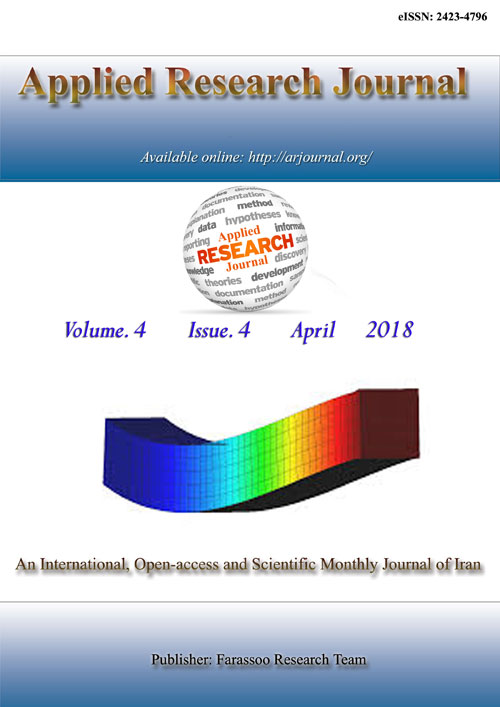فهرست مطالب
Applied Research Journal
Volume:2 Issue: 9, Sep 2016
- تاریخ انتشار: 1395/07/14
- تعداد عناوین: 4
-
Pages 370-378Three types of additive: limestone powder and two kinds of water-soluble polymers (Carboxymethyl-cellulose (CMC), and polyvinyl alcohol (PVA)) have used in this research to study their effect on physical and mechanical properties of White Cement mortar. The mixing ratio was 1:3 for (cement: sand) of White cement mortar. The limestone powder ratios are (4%, 8%, and 12%) by weight of the mixture. While the Carboxymethyl-cellulose ratios are (0.25%, 0.5%, and 1%) by weight of the mixture and the polyvinyl alcohol ratios are (1%, 3%, and 5%) by weight of mixture. This research investigates compressive and flexural strength, water absorption and drying shrinkage were also examined of the modified mortar. Moreover, a nondestructive test of ultrasonic pulse velocity was used in this research. The test results show that using limestone powder within White cement mortar is not proposed because it has negative effect on both mechanical and physical properties of cement mortar. Furthermore, reducing cracks of White cement mortar is meaningfully improved by using polymer additives such as PVA and CMC. Also, the optimum percentages of polymer addition are 3% and 0.25% of PVA and CMC, respectively.Keywords: Carboxymethyl, cellulose, reducing cracks, limestone, polyvinyl alcohol, white cement
-
Pages 379-383Carbon dioxide (CO2) emissions are believed to be a major contributor to global warming. As a consequence large anthropogenic CO2 sources worldwide will eventually be required to implement CO2 capture and storage technologies to control CO2 emissions. Many extensive research works have been carrying out to improve the constraints of existing technology. Unfortunately no current technologies for removing CO2 from source exist which satisfy the need of safety, efficiency and economically. Nanotechnology can play an important role to provide viable material solutions to the challenges of cost-effective, energy efficient and highvolume CO2 capture. This minireview highlights some recent promising research activities and their prospects in the area of carbon capture with reference to nanotechnology based solutions. The potential opportunities and challenges that face future trends of nanotechnology applications in the CO2 capture and storage are also discussed.Keywords: Nanomaterials, Carbon dioxide (CO2), Capture, Nanosorbents
-
Pages 384-393The effect of reinforcing the mortar with glass fibers in different alignment beside the addition of styrene butadiene rubber (SBR), were investigated in this work to show their influence on some physical properties. Different series were prepared, two of them were reinforced the mortar with glass fibers in two manner (random and layers). The others series were the same with the addition of SBR. These series were immersed in water with controlled conditions for 7 and 28 days. The glass fibers were added in different weight percentages (0, 54, 0.76, 1.1 and 1.42). The SBR was added at 7 % from water. Water absorption, ultrasound velocity and acoustic impedance were measured after preparing the specimens and com [paring them with controlled specimens. The results showed an improvement in mortar properties by reduction of water absorption, ultrasound velocity and acoustic impedance as well as producing lighter weight than conventional mortar. The best results were achieved by reinforcing with glass fibers layers in presence of Styrene Butadiene rubber after curing for 28 days.Keywords: Random glass fibers, Glass fibers layers, SBR, Water absorption, Ultrasound velocity, Acoustic impedance
-
Pages 394-402To optimize the utilization of thermal conversion systems, it is essential to integrate them with thermal energy storage. Among many types of base materials, the phase change materials (PCMs) are the most satisfactory mediums to store and release the thermal energy due to their high latent heat of fusion. In general, the (PCMs) have low thermal conductivity. Nano additives have been investigated to further enhance the thermal properties of the (PCMs). In this study, the thermal conductivity of paraffin wax has been enhanced by adding different mass concentration (1wt. %, 3wt. %, 5wt. %) of (TiO2) nanoparticles with about (10nm) diameter. It is found that the phase change temperature varies with adding (TiO2) nanoparticles in to the paraffin wax. The thermal conductivity of the composites is found to decrease with increasing temperature. The increase in thermal conductivity has been found to increase by about (10%) and (7%) by using spherical and trapezoidal capsules respectively at nanoparticles loading (5wt. % and 15oC).Keywords: Phase change materials (PCM), Thermal conductivity, TiO2


